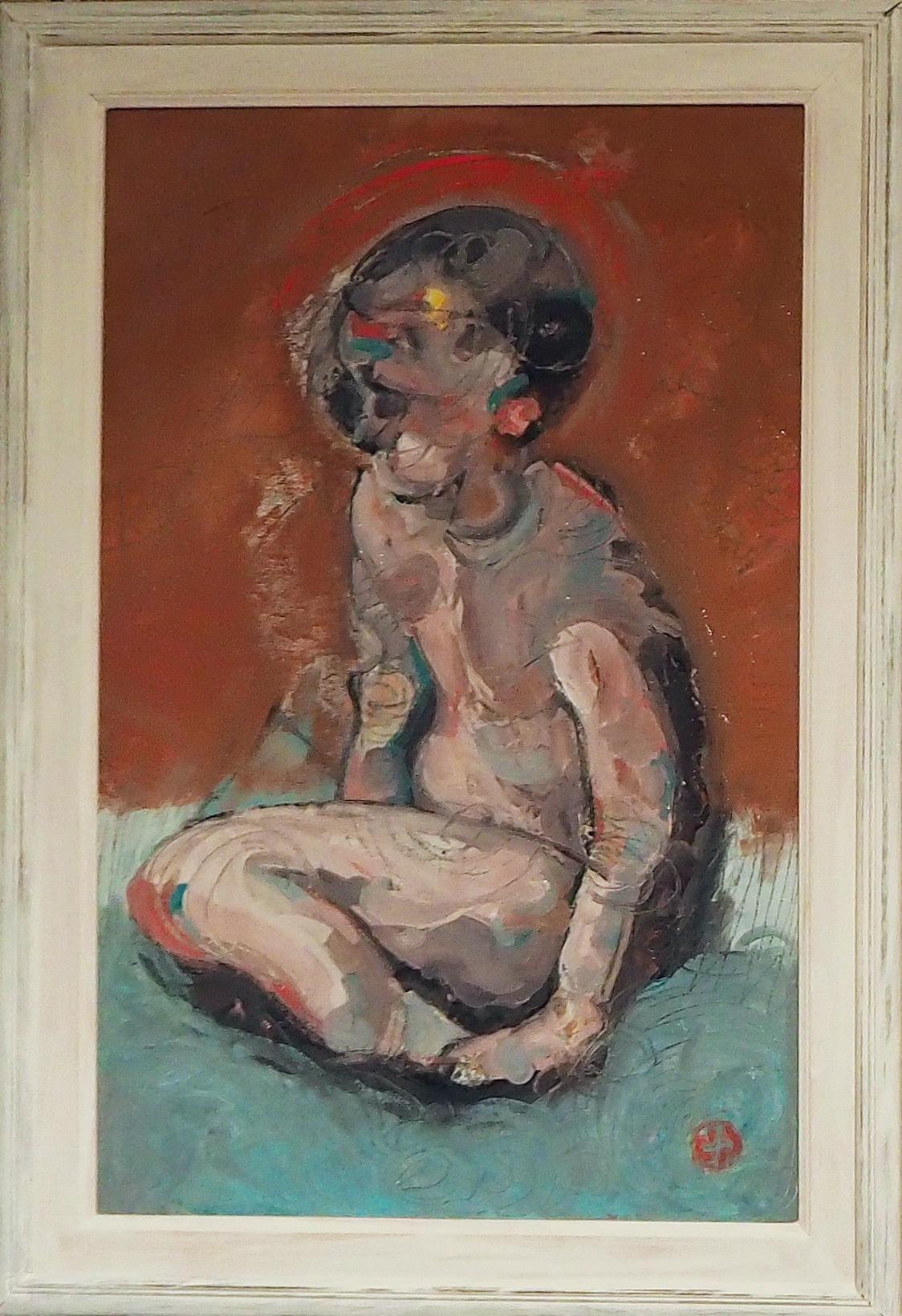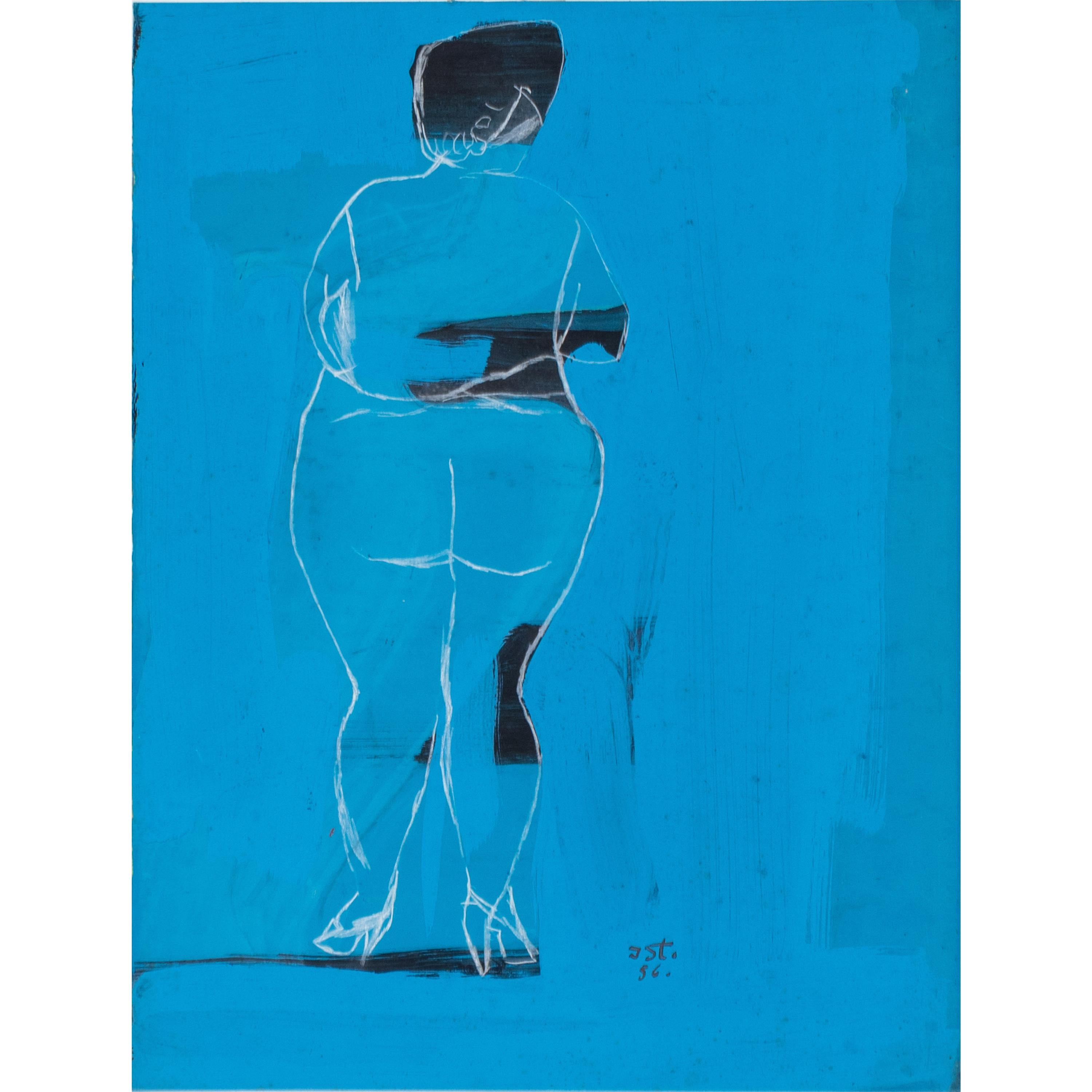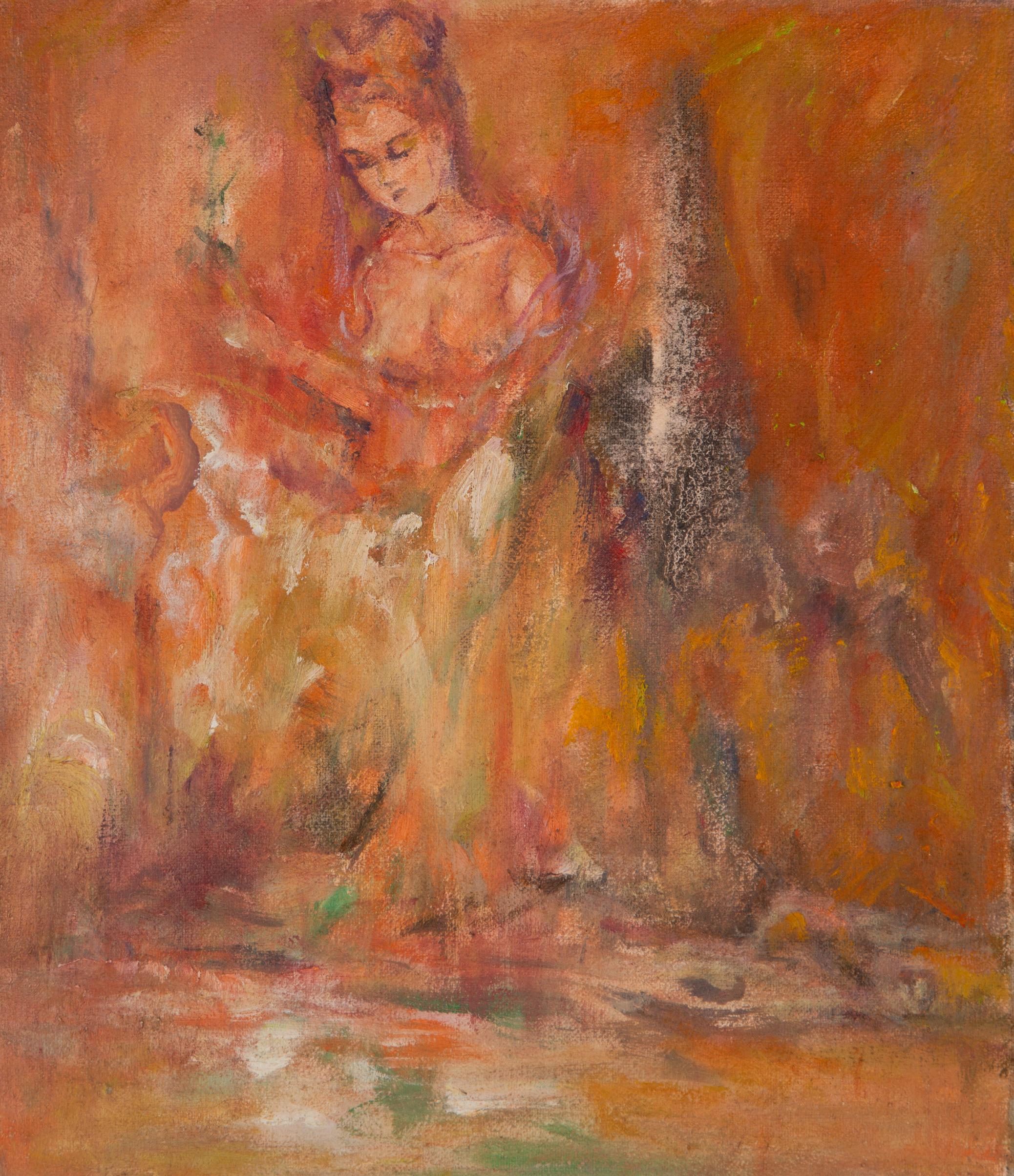Edward MarecakDiana and the Three Fates, Vintage 1970s Semi Abstract Figural Oil Painting1970s
1970s
About the Item
- Creator:Edward Marecak (1919 - 1993)
- Creation Year:1970s
- Dimensions:Height: 18.25 in (46.36 cm)Width: 48 in (121.92 cm)Depth: 0.2 in (5.08 mm)
- Medium:
- Movement & Style:
- Period:
- Framing:Framing Options Available
- Condition:very good vintage condition.
- Gallery Location:Denver, CO
- Reference Number:
Edward Marecak
Edward Marecak was an American painter who was born in 1919. Growing up in the farming community of Brunswick, Ohio, he showed early artistic promise, hired by the National Youth Administration to document historic barns. In 1946, Marecak came to the Colorado Springs Fine Arts Center for a year and after a semester interlude at Cranbrook returned to study lithography with Lawrence Barrett. There he also met his future wife and sometime collaborator, ceramicist Theresa Madonna Fortin. Given the opportunity to teach a summer course at the University of Colorado, he decided to obtain a teaching certificate at the University of Denver and subsequently embarked on his 25-year career in the Denver Public School system. Rather than pursue fame, Edward Marecak directed his zeal toward fostering younger generations in the principles of art as well as his simple philosophies. Moreover, his teaching salary allowed him to ply his prodigious talent at whatever he pleased, instead of bending to the dictates of trends and sales. Having inherited his faith in education from his Slovakian immigrant parents, Marecak could add the shaping of lives to his mastery of art forms, including lithographs, monoprints, drawings, hooked rugs, ceramics, paintings, wood sculptures, stained-glass windows and jewelry. While exhibiting in his lifetime, he was, in his wife’s words, “his own greatest collector”, but shows and his popularity at the Kirkland Museum have positioned Marecak posthumously among Colorado’s pre-eminent modernists. As a child, Marecak was enthralled by the Carpathian tales of magic and supernatural beings told by his grandmother. As with other artists with roots in Eastern Europe, his artistic turn to folk tradition would free him from learned practices of perspective and modeling in favor of flat patterns within patterns and brilliant, throbbing color. While others ventured further into abstraction, Marecak stylized figurative elements into crowded compositions that appeared like a mosaic or stained glass. As he matured, he could declare, “I am still very much a Byzantine designer and my joy with what color can do grows all the time”. The traceries of strong outlines and bold shapes provide compartments for vibrant colors, contrasts and rough textures that can scarcely be contained. The Kirkland Museum staged a retrospective of Edward and Donna Marecak in 2007.
- ShippingRetrieving quote...Ships From: Denver, CO
- Return PolicyA return for this item may be initiated within 7 days of delivery.
- Goddess of Fertility, 1960s Semi Abstract, Nudes, Flowers, Red Blue Yellow GreenBy Edward MarecakLocated in Denver, COGoddess of Fertility, vintage 1960s original oil painting by Edward Marecak (1919-1993), semi abstract with somewhat cubist nude female and male figure in an interior scene with flow...Category
Mid-20th Century Abstract Abstract Paintings
MaterialsCanvas, Oil
- 'Zeus, Venus and Hera' - 1980s Semi Abstract Painting, Nude Figures, MythologyBy Edward MarecakLocated in Denver, COSemi-abstract figurative oil painting by Denver modernist Edward Marecak (1919-1993). Titled 'Zeus, Venus, and Hera', painted in 1982 . Cubist, stylized figures depicting gods and goddesses from ancient mythology. Central to the painting is a male figure depicting Zeus, the Greek god of the sky, shown in the nude in rich shades of brown with a beard and bright blue eyes. His arms are wrapped around Venus, the Roman goddess of love, and Hera, the Greek Goddess of marriage and women. The trio is seated on a blue green chair...Category
1980s American Modern Abstract Paintings
MaterialsOil
- 1950s Abstract Painting New York Skyline Cityscape, Buildings, Blue Yellow RedBy Charles Ragland BunnellLocated in Denver, COVintage 1950s original signed abstract painting of New York City by Charles Ragland Bunnell from 1951, cityscape mid century modern skyline. Presented in a custom black frame, outer dimensions measure 21 ⅜ x 26 ⅜ x 2 inches. Image size is 19 x 24 inches. Painting is clean and in very good vintage condition - please contact us for a complete condition report. Expedited and international shipping is available - please contact us for a quote. About the artist: Charles Bunnell developed a love for art at a very young age. As a child in Kansas City, Missouri, he spent much of his time drawing. When he was unable to find paper he drew on walls and in the margins of textbooks for which he was often fined. Around 1915, Bunnell moved with his family to Colorado Springs, Colorado. He served in World War I and later used his GI Training to study at the Broadmoor Art Academy (later renamed the Colorado Springs Fine Arts Center) during 1922 and 1923. In 1922, he married fellow student, Laura Palmer...Category
1950s Abstract Abstract Paintings
MaterialsOil, Board
- Fertility Goddesses, Abstract Nude Figures 1950s Oil Painting, Pink, Blue, GreenBy Edward MarecakLocated in Denver, COFertility Goddesses, original abstract figurative painting, vintage 1950, by 20th century Denver modernist artist, Edward Marecak (1919-1993). ,Three nude female figures with fruit. ...Category
1950s Abstract Portrait Paintings
MaterialsOil, Board
- American Modernist Abstract Still Life Painting with Zinnia Flowers, Red OrangeLocated in Denver, COOil on board painting by Paul Kauvar Smith (1893-1977) of a still life of flowers on a table in an interior scene with a mirror in the background. American Modernist still life painting with zinnias and abstract paintings in an artists studio. Presented framed, outer dimensions measure 27 ⅝ x 31 ¾ x 1 ⅛ inches. Image size is 19 ½ x 23 ½ inches. Painting is clean and in very good vintage condition - please contact us for a detailed condition report. Provenance: Private collection, Denver, Colorado Expedited and international shipping is available - please contact us for a quote. About the Artist: In 1915, Paul Kauver Smith studied commercial art and design at the St. Louis School of Fine Art for two years. His studies were interrupted by World War I during which he served as a corporal in the U.S. Army. After the war he returned to the School of Fine Art and also studied at the Washington University School of Fine Arts in St. Louis with Fred G. Carpenter, himself a student of Jean-Paul Laurens at the Colarossi Academy in Paris. Carpenter was known as a marvelous colorist who "thought every inch of a painting should be fascinating…and should be as interesting close up as from a distance." His approach is reflected in many of Smith’s paintings, both representational and abstract in style, done later in Colorado. In 1921, Smith relocated to Denver where he studied for two years at the Denver Academy of Fine and Applied Arts, formerly located in Brinton Terrace on 18th Street in Denver’s Capitol Hill neighborhood. His teacher was John E. Thompson, another important influence as a pioneer of modernism in Denver. The Academy hired Smith as an instructor in 1923 and that same year the Denver Art Museum included his work for the first time in its 29th annual juried exhibition. He later had two solo shows at the museum, which added his work to its Anne Evans Collection. In 1959 the museum reproduced Houses at Victor, for its Western Heritage Exhibition catalog. During the year of 1928 he witnessed the Articles of Incorporation of the Denver Artists Guild, comprising most of the city’s professional artists. He also belonged to the American Artists Professional League, also organized in 1928 by fifteen members of the Salmagundi Club in New York to protect artists’ interest and promote traditional American art. He was one of some two dozen Colorado artists designated to participate in the Public Works of Art Program (PWAP, 1933-34), the first federally-sponsored program for artists during the Great Depression. Around 1928 Smith became the "Hermit of Stuart Street," and remained a life-long bachelor. One painting, View from My Window, depicts his immediate neighborhood. Living for more than thirty years at 1039 Stuart Street in West Denver, he gave up creature comforts that most people take for granted to have the freedom to devote his life to the pursuit of art. In the first twenty-five years of his career, his paintings focused on the Colorado landscape and its mining towns with their decaying buildings as relics of the past. His piece, Miner’s House at Victor, Colorado illustrates the description of his work in this genre as described by Denver artist and art writer, Arneill Downs, "The jewel-like shapes and colors the artist uses gives the most decrepit objects style. The decaying buildings of ghost towns, grouped together on canvas, glow like a patchwork quilt." Smith described his technique as "I start lean and finish fat." He worked first with turpentine as a medium and ended up with pure pigment put on with a palette knife. In addition to Colorado scenes...Category
20th Century Abstract Still-life Paintings
MaterialsOil, Board
- New York City Abstract Skyline, Semi Abstract Night Scene Cityscape Oil PaintingBy Charles Ragland BunnellLocated in Denver, COOil on board painting of abstracted New York City skyline by Charles Ragland Bunnell from 1951. Nocturne cityscape painted in colors of black, shades of blue, and yellow. Presented in a custom black frame, outer dimensions measure 30 ¼ x 12 ¼ x ¾ inches. Image size is 30 x 12 ¼ inches. Painting is in good vintage condition - please contact us for detailed condition report. Provenance: Estate of Charles Ragland Bunnell Expedited and international shipping is available - please contact us for a quote. About the Artist: Charles Bunnell developed a love for art at a very young age. As a child in Kansas City, Missouri, he spent much of his time drawing. When he was unable to find paper he drew on walls and in the margins of textbooks for which he was often fined. Around 1915, Bunnell moved with his family to Colorado Springs, Colorado. He served in World War I and later used his GI Training to study at the Broadmoor Art Academy (later renamed the Colorado Springs Fine Arts Center) during 1922 and 1923. In 1922, he married fellow student, Laura Palmer...Category
1950s Abstract Abstract Paintings
MaterialsOil, Board
- Collection of Three French Oils on Board. "La Cagole, Redoutable & La Corrida".Located in Cotignac, FRLate 20th century collection of three abstract expressionist oils on board by French artist Emmanuelle Bardet. All signed to the front and each dated 1995 and titled to the reverse. The three paintings are titled; La Cagole...Category
Late 20th Century Abstract Expressionist Abstract Paintings
MaterialsOil, Board
- Political (body) Stance IIIBy Diogenis PapadopoulosLocated in Spetses, GRPapadopoulos challenges the abstract and the figurative in a whirlwind combination of colours that paint patterns of expression within the recognisable human form. Dimensions without...Category
21st Century and Contemporary Abstract Abstract Paintings
MaterialsOil, Board
- Josef Steiner (1899-1977), Abstract female nude, dated 1956By Josef SteinerLocated in Greding, DEAbstract female figure on a blue ground. Monogrammed and dated in the lower centre. Josef Steiner (1899 Munich - 1977 ibid.) lived through a Germany in all its facets as an artist. A...Category
20th Century Abstract Expressionist Nude Paintings
MaterialsOil, Cardboard
- Bo Zhang Abstract Original Oil On Canvas "Ancient Chinese Ladies"Located in New York, NYTitle: Ancient Chinese Ladies Medium: Oil on canvas Size: 13.5 x 11.5 inches Frame: Framing options available! Condition: The painting appears to be in excellent condition. Note: Thi...Category
21st Century and Contemporary Abstract Expressionist Nude Paintings
MaterialsCanvas, Oil
- Monday's Muse, Large Abstract Nude Painting by Darryl HughtoBy Darryl HughtoLocated in Long Island City, NYMonday’s Muse by Darryl Hughto, American (1943) Date: 1988 Oil on Canvas, signed and dated verso Size: 55 x 42.25 in. (139.7 x 107.32 cm) Frame Size: 57.5 x 44.25 inchesCategory
1980s Abstract Expressionist Abstract Paintings
MaterialsCanvas, Oil
- Political (body) Stance IBy Diogenis PapadopoulosLocated in Spetses, GRDimensions of frame: 106x86 (wood) Oil on canvas, ready to hang.Category
21st Century and Contemporary Abstract Nude Paintings
MaterialsCanvas, Oil






